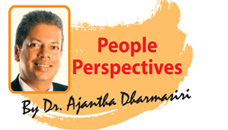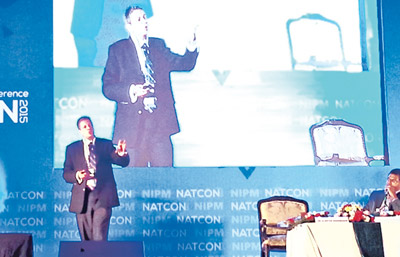|
34th NIPM conference in Tamil Nadu:
'Tech-tradi tribe' worth exploring further
 The theme for the 34th National Institute of Personnel Management (NIPM)
in Tamil Nadu, India, was 'Winnovate HR for Business and People'. It was
meant to brainstorm industry best practices and benchmark recent ROI-driven
approaches and applications to people management that have produced
stunning results for businesses, across the globe. The theme for the 34th National Institute of Personnel Management (NIPM)
in Tamil Nadu, India, was 'Winnovate HR for Business and People'. It was
meant to brainstorm industry best practices and benchmark recent ROI-driven
approaches and applications to people management that have produced
stunning results for businesses, across the globe.
My first visit to Tamil Nadu was memorable as I was one of the
speakers at the Annual Conference.
Representing the Institute of Personnel Management (IPM) Sri Lanka,
the pioneering opportunity of being a Sri Lankan speaker at an NIPM
event was indeed significant, keeping Sri Lanka's flag high. Today's
column is all about the essence of what I experienced. The signature
annual conclave of the National Institute of Personnel Management (NIPM),
NATCON 2015 was a memorable event for HR executives to expand their
knowledge and share their experiences.
The coining of the term 'winnovation' was quite interesting. In the
technology-led, competition-intensified, global business economy, CEOs
and the HR fraternity know that to survive, their businesses must
change, but aren't quite sure what people-centric practices still apply
and which must be retooled to serve new business challenges.
The need for long-term focus was pronounced louder in the years
following the financial crisis. Yet in the midst of so much change and
complexity, even the most progressive companies can struggle to fully
engage their employees, customers and business allies in ways that
create mutual benefit.
They know that in the dynamic business environment, the symbiotic
relationship between organizations and people must also shift in
profound ways. Economic volatility, the erosion of trust, the desire for
sustainable lifestyles and the ability to instantly communicate across
social networks have converged to create a new and exciting business
environment that must be embraced to remain in business.
 It is widely accepted among business leaders that innovation is vital
to competitive advantage and long term success and innovation is one of
the three top challenges CEOs face today. The ability to innovate and
sustain it for business growth and stability is the predictor of the
future. It is widely accepted among business leaders that innovation is vital
to competitive advantage and long term success and innovation is one of
the three top challenges CEOs face today. The ability to innovate and
sustain it for business growth and stability is the predictor of the
future.
Top challenges
Winnovation is every stakeholder's responsibility because, more than
technology, its human capital that's driving change all around us. The
most successful corporate innovation strategies are those that
predominantly focus on people and human capital rather than technology
playing an important role. Among the sub-themes were, evolving next
generational leaders, reverse mentoring and unlearning. I was invited to
focus on this broad sub-theme.
Upon contemplating, I realized the need to emphasize the similarities
and differences of millennials of South Asia and the West. Much has been
discussed about millennials in multiple media. Since William Strauss and
Neil Howe came up with the Generations Theory in the early 1990s with
their seminal book, people all over the world started paying attention
to the existence of multiple generations in workplaces.
Millennials or Generation Y employees who were popularly known as to
have been born between 1980-1999 have differences in their perceptions,
preferences and performance. They are much more tech-savvy compared to
their generation X predecessors, having been exposed to rapid
advancement in information and communication technology during past
decades.
They are also for more flexible work arrangements. Millennials have a
'can-do' attitude about tasks at work and look for feedback about how
they are doing frequently. Millennials want a variety of tasks and
expect to accomplish all of them. Positive and confident, they are ready
to take on the world.
Interesting phenomenon
While the classification of generations shed much light on how people
of different ages behave differently, it highlighted its own limitations
as well.
One obvious factor among all these generations is that the very same
names are associated with events that took place in the West, and to a
very high extent in the USA. The degree of relevance and applicability
to South Asia is questionable.
One-fifth of the world's population is housed in South Asia.
Obviously, it is a humanly rich (HR) region. Yet, it is only second to
Sub-Saharan Africa with regard to poverty. I see a paradox here. On one
hand we have brilliant brains. More than 70 percent of NASA scientists
are from South Asia. On the other hand, we have the worst forms of
poverty.
The co-existence of the best brains and worst poverty is an
interesting phenomenon.
In extending the South Asian specialty to millennials, we see some
clear differences. While the tech-savvy nature is universally
consistent, the key difference emerges in the spheres of religion and
culture. Recent research on millennials across the globe has highlighted
such differences promptly. Attitude towards marriage, approach towards
family and respect towards religions are some key differentiating
factors among South Asian millennials. On one side they are ardent fans
of technology. On the other side, they are active upholders of
tradition. I would coin the term 'tech-tradi tribe' to describe such
distinct millennials in South Asia.
It reminds me of what the late Prof. Uditha Liyanage said of the
mode-tradi consumer in Sri Lanka. We see many young Sri Lankans tying a
pirith noola and a Levis jean, in showcasing their association with
modernity and tradition.
In a globalized world, we are influenced, or even dominated by a
western thought process, overshadowing indigenous realities.
Multi-generational classification is one such example. The emerging
leaders in South Asia representing the tech-tradi tribe will show the
world their distinct difference.
The treasures and travails of the 'tech-tradi' tribe have stressed
the need to be further explored. They are already in our workplaces.
They want to be lean, seen and green, in going, growing and glowing. The
enthusiastic response I received in Coimbatore is ample proof that the
'tech-tradi tribe' is worth exploring further. As the IPM and the NIPM
deal with emerging leaders, collaborative research in South Asia is a
possibility.
The writer, a Professor in Management, is the director and the
chairman of the board of management of the Postgraduate Institute of
Management. He also serves as an adjunct professor in the Division of
Management and Entrepreneurship, Price College of Business, University
of Oklahoma, USA. He can be reached through
[email protected]
|

